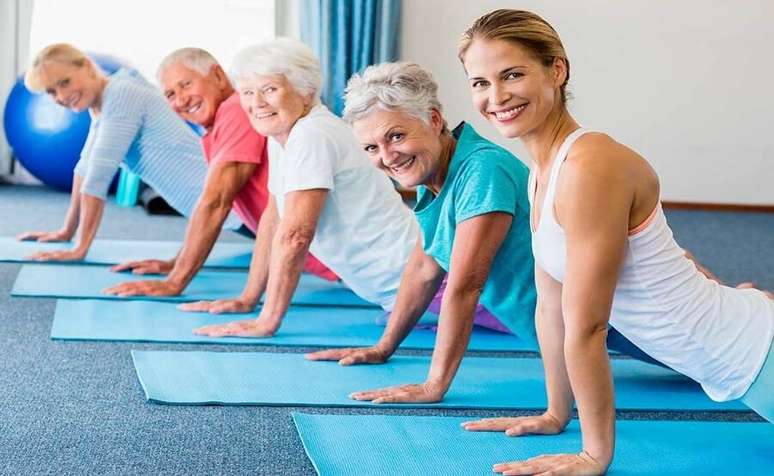The expert explains the importance of physical activity in old age
Physical activity in old age is a crucial element for maintaining health and quality of life. Starting in your 40s, your body begins to gradually lose muscle mass, a process known as sarcopenia. This loss of muscle mass significantly affects the functional capacity of individuals, impacting their autonomy and independence.
Studies indicate that the rate of muscle loss can accelerate as we age. According to an article published in the Journal of Cachexia, Sarcopenia and Muscle, individuals over the age of 40 can lose an average of 3% to 8% of muscle mass every decade. The consequence of this loss is not only a decrease in strength, but also a negative impact on the body’s vital systems.
Reduction in muscle mass is associated with negative effects on the circulatory system, increasing the risk of cardiovascular disease. Additionally, muscle weakness can lead to increased blood pressure and a greater risk of type 2 diabetes.
“Joint pain and an increased susceptibility to falls and fractures are also common complications related to loss of muscle mass in older age,” says physical educator Giulliano Esperança.
However, regular physical activity can mitigate these effects. Resistance exercises, in particular, are essential for maintaining and even increasing muscle mass in older people. Such exercises not only strengthen muscles, but also improve blood circulation, reduce blood pressure and help control blood glucose levels.
Physical activity is essential in old age
More than maintaining physical health, physical activity in old age is fundamental to quality of life. It allows people to continue carrying out their daily activities, maintaining their independence and autonomy. Furthermore, regular movement contributes to mental health, reducing the risk of depression and improving self-esteem.
The practice of conscious and intentional movements goes beyond physical exercise; It connects with the fulfillment of dreams and life with loved ones.
“Full attention to movement and harmony between body and mind are essential for a full and satisfying life, especially in old age,” warns Giuliano Esperança.
Therefore, the importance of physical activity goes beyond simply maintaining muscle mass. It is an integral part of a lifestyle that values every movement, every breath and every moment experienced, allowing people not only to live longer, but to live better.
Physical independence in old age is a crucial pillar for maintaining dignity and quality of life. The ability to carry out daily activities without external dependence is not just a question of functionality, but an intrinsic right to live with fullness and self-esteem. Through regular physical activity, older adults can maintain and, in some cases, regain independence, which has a direct impact on their sense of fulfillment and independence.
Emotional and cognitive impact
Beyond the physical aspect, the emotional and cognitive impact of physical activity in later life is profound. This stage of life can often be marked by feelings of loneliness and isolation, which can trigger or worsen depression. Regular exercise has been shown to be an effective tool for mitigating these symptoms.
Studies indicate that regular physical activity not only improves mood, but also significantly contributes to mental health by promoting the release of endorphins, known as happy hormones.
Furthermore, physical activity has a positive impact on cognitive function. Practicing exercises, especially those that encourage coordination and balance, can improve concentration, memory and other cognitive functions.
According to research published in the British Journal of Sports Medicine, regular physical activity is associated with a lower risk of cognitive decline in older adults. This suggests that integrating movement into your daily routine is not only beneficial for the body, but is also vital for keeping the mind agile and healthy.
The link between movement and emotional health in old age is inseparable. By encouraging regular physical activity, we promote not only longevity, but also the experience of an emotionally rich and cognitively active life.
This holistic approach to well-being emphasizes that every step, every movement, every physical effort is an investment in the very essence of being human. By cultivating physical health, we simultaneously cultivate mental and emotional health.
Transcend body maintenance
Physical activity, therefore, transcends mere maintenance of the body. It becomes an act of affirmation of life, of respect for one’s history and celebration of personal abilities. As each individual ages, he or she has the right to experience not only additional years of life, but more life for his or her years, filled with autonomy, dignity and joy.
In short, promoting physical activity at the best age means promoting active and healthy aging, where dignity, autonomy and emotional fullness are seen not as a luxury, but as fundamental elements of a life well lived.
It is an invitation to everyone, regardless of age, to continue writing their own story with vigor, joy and full awareness of their own inestimable value.
The importance of the squat exercise
One of the most basic and beneficial physical activities for seniors is squats, including its most accessible variant – the exercise of sitting down and getting up from a chair. This simple yet powerful movement has a direct correlation with autonomy and longevity.
Scientifically, squats are recognized for strengthening multiple muscle groups, especially those involved in locomotion and balance. According to a study published in the European Journal of Preventive Cardiology, the ability to sit and get up from the floor without assistance is associated with a lower mortality rate in older adults. This act, which may seem trivial, is actually a robust indicator of muscle strength and health, as well as flexibility.
Regularly performing sit-to-stand exercises, or full squats when possible, contributes significantly to maintaining functional independence. Such movements not only increase muscle strength but also improve coordination, balance and general mobility. This is critical, as the ability to move confidently without assistance is an essential component of independence in daily life.
Furthermore, practicing these exercises has an impact on the prevention of falls, one of the main causes of serious injuries in the elderly. By strengthening leg muscles and improving balance, the risk of falls is significantly reduced, promoting greater safety and confidence in carrying out daily activities.
Incorporating squats or sitting and standing movements into a regular workout routine isn’t just a strategy for maintaining physical health. It is also an investment in longevity and the ability to live independently and with dignity. These movements are the symbol of personal autonomy, representing the power and importance of daily actions in maintaining quality of life.
Therefore, encouraging and practicing these simple but effective exercises is crucial to any physical activity program aimed at older adults. They represent much more than a simple component of a workout; they are a celebration of each individual’s strength, resilience and ability to face the challenges of aging with confidence and independence.
“So, as we approach physical activity in the prime of life, or at any stage of life, it is essential to recognize that every movement is an opportunity to nourish not only the body, but also the heart. In my research and practice, I strive to May every action reflect this motto, combining the science of movement with the art of loving and caring”, concludes Giuliano Esperança.
inspires transformation in the world of work, in business, in society. Compasso, a content and connection agency, is born.
Source: Terra
Ben Stock is a lifestyle journalist and author at Gossipify. He writes about topics such as health, wellness, travel, food and home decor. He provides practical advice and inspiration to improve well-being, keeps readers up to date with latest lifestyle news and trends, known for his engaging writing style, in-depth analysis and unique perspectives.









